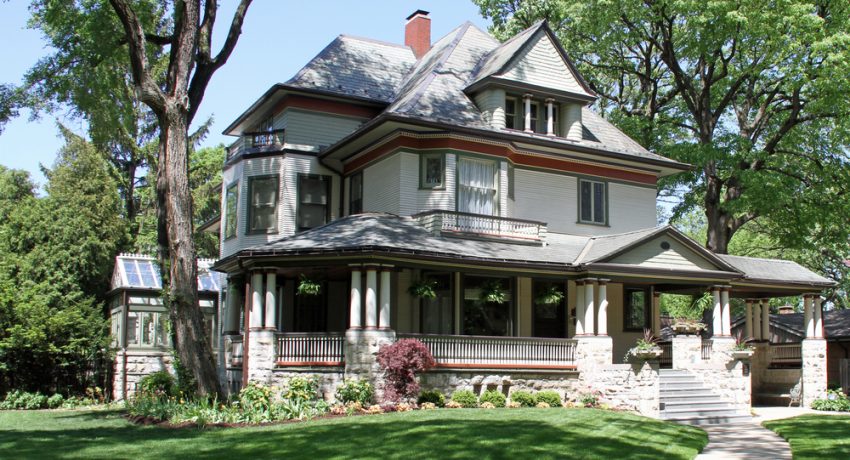The fusion of past and present come together beautifully in older homes. Helping clients find a house with a rich history can be a challenge. Once there are one or more prospects, it’s time to discuss specifics about buying old homes. Consider these seven facts every agent should tell clients about buying a historic home.
Residing in a Historic District
Most older homes are in a village or historic district built before all the other houses in the area. Typically, the historic district maintains a constant property value and often offers amenities such as a local community organization dedicated to preserving the integrity of the city. Plus, these areas usually include shops, restaurants, churches, and other popular venues.
While there are definite benefits associated with living in a historic area, there are also potential restrictions. All the houses in a landmark area face the same limitations, such as only using specific color paint and window types. State and local governments establish the criteria and constraints for historic homes. In some regions, homeowners must apply to proceed with any renovations to the house, even if they are minor.
National Historic Criteria
State and local registries establish historic restrictions in these older districts. The goal is to maintain the historical feel of the area by assessing time-specific features and ensuring they exist at each property. For example, all of the homes might have square windows with black shutters. It would be likely homeowners could not paint these shutters purple.
A district listed solely on the National Register of Historic Places does not face any restrictions. Before clients decide to buy a historic home, find out if it has a historic preservation easement. In some instances, payment must be made to a government agency to hold this historic easement that dictates the restrictions homeowners must follow. Inquire if a federal tax deduction is available for those who hold an easement.
Be Prepared for the Cost of Renovations
Maintaining historic integrity can become expensive for unsuspecting property owners. Clients should be prepared for the potentially high cost of renovations, especially if specific parts or colors are required. Adhering to historical restrictions can become costly. Homeowners should be ready to spend extra money on simple repairs.
Buying a historic home that needs a lot of work can add up to a large renovation bill. Without a solid income and savings, property owners could find themselves struggling to keep up with repairs. One way to offset the cost of renovation is to find out if the state offers tax programs or grants for homeowners making updates to older properties.
Securing Insurance
With the substantial cost of renovation in mind, it can be tough to find the right insurance for historic homes. A general policy may not account for the increased costs associated with repairing an older house, especially if there are restrictions. When there are no restrictions, the price of insurance might be lower. Shopping around is crucial to get the right level of coverage at a competitive rate.
Insurance should cover renovations, replacements, and damages. A video of a historic home is an excellent marketing tool for agents that can later be used by the buyers to show the uniqueness of the home to insurance providers.
Limited Space and Use
Historic homes were built decades ago with a lifestyle in mind. These habits have changed with the times, which means the layout could be outdated. Often older homes have smaller rooms, winding hallways, and fewer open spaces. As a result, the smart use of space could be impossible, and some modern updates may not fit into the living areas.
Plus, it could be against the legal restrictions to build an addition to a historic house. Buyers will not be able to add a floor or room to accommodate a growing family or home business. Clients should be aware they will be limited on how much space they have, as expansion is usually impossible.
Financing Challenges
If a historic house requires extensive repairs, a traditional loan might not be an option. Creative financing options are available, depending on the condition of the house and the buyers’ financial situation. For example, a private HUD loan can cover small renovations. Other rehab loans may also be available, including a 203K and a Fannie Mae renovation mortgage.
Agents working in a historic area should maintain a list of go-to resources for historic home buyers. Include lenders, insurance providers, contractors, and attorneys who understand the devil is in the details when it comes to owning, repairing, maintaining, financing, and insuring historic properties.
Consider Energy Efficiency
Going green is a modern mantra that had little meaning one hundred years ago. With the advent of industry and technology came a host of other concerns, including the cost of providing utilities to a home. Poor insulation, outdated electrical systems, and drafty windows are all ways energy gets wasted. But since some renovations are restricted or impermissible, making energy-efficient updates could be a challenge.
Over time, historic homes have enjoyed tech-inspired updates. Property owners must be prepared to petition for essential changes, wait to get results and pay the cost of utilities in the meantime until green changes can be initiated. Affiliated Better Homes and Gardens® Real Estate agents can often pass on cost savings to their clients for storage, protection, and other property services. Helping clients find a house with a story is a sure way to be remembered and recommended. When clients are determined about buying a historic home, be the voice of information and reason every step of the way to ensure they are ready for the experience.








